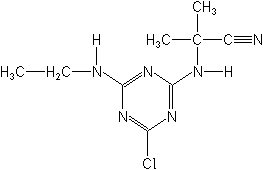-
Common NameCyanazine
-
中文通用名氰草津
-
IUPAC2-(4-chloro-6-ethylamino-1,3,5-triazin-2-ylamino)-2-methylpropiononitrile
-
CAS2-[[4-chloro-6-(ethylamino)-1,3,5-triazin-2-yl]amino]-2-methylpropanenitrile
-
CAS No.21725-46-2
-
Molecular FormulaC9H13ClN6
-
Molecular Structure
-
Category
-
ActivityHerbicide
-
PremixPremix Parters: ethephon; mepiquat chloride;
-
Physical PropertiesMolecular weight:240.7; Physical form:Tech. cyanazine is a white crystalline solid. Density:1.29 kg/l (20 °C); Composition:Tech. grade 95% pure. Melting point:167.5-169 °C (tech., 166.5-167 °C); Vapour pressure:2×10-4 mPa (20 °C); Partition coefficient(n-octanol and water):logP = 2.1; pKa:0.63, v. weak base; Solubility:In water 171 mg/l (25 °C). In methylcyclohexanone, chloroform 210, acetone 195, ethanol 45, benzene, hexane 15, carbon tetrachloride <10 (all in g/l, 25 °C).; Stability:Stable to heat (1.8% decomposition after 100 h at 75 °C), and to light. Stable in solution between pH 5 and 9, hydrolysed by strong acids and alkalis.
-
ToxicologyOral:Acute oral LD50 for rats 182-334 mg/kg, mice 380 mg/kg, rabbits 141 mg/kg. Percutaneous:Acute percutaneous LD50 for rats >1200, rabbits >2000 mg/kg. Non-irritating to skin and eyes. Inhalation:LC50 >2460 mg/m3 air, as cyanazine dust. Phytotoxicity:Selective if applied according to label recommendations.
-
Environmental ProfileEcotoxicology: Algae:EC50 (96 h) <0.1
mg/l.Bees:Not toxic to bees. LD50(topical) >100 μg/bee (tech. in acetone); (oral) >190 μg/bee (tech. as dust).Birds:Acute oral LD50 for mallard ducks >2000, quail 400 mg/kg.Daphnia: LC50 (48 h) 42-106 mg/l.Fish:LC50 (48 h) for harlequin fish 10 mg/l; LC50 (96 h) for fathead minnow 16 mg/l. Environmental fate: Animals:In rats and dogs, following oral administration, cyanazine is rapidly metabolised and eliminated within c. 4 days.Soil:Microbial degradation in soil occurs within one growth period. Metabolism is similar to that in plants. DT50 in soil c. 2 w. (K. I. Beynon et al., Pestic. Sci., 1972, 3. Plant:In plants, the nitrile group is hydrolysed to a carboxylic acid group, and the chlorine atom is replaced by a hydroxy group (K. I. Beynon et al., Pestic. Sci., 1972, 3, 293-305). -
Transport InformationSignal Word:WARNING; Hazard Class:II (Moderately hazardous)
Porduct NewsMore
Orthosulfamuron boosts sugarcane production, study finds
Glyphosate price plummets 40% in one year in Argentina
Indian govt stops imports of herbicide Glufosinate priced below Rs 1,289 per kg
Carbendazim fungicide wins victory in Brazilian Parliament
Corteva presents new pre-emergent herbicide Linear for sugarcane in Brazil
Picloram Triclopyr Aminopyralid
Revolutionizing disease prevention: BASF launches new rice fungicide Cevya® in China
Thiamethoxam is allowed again in Brazil by a judicial decision
Bayer develops alternative to glyphosate herbicide
Related CompaniesMore
Country: China
Glufosinate-ammonium 2,4-D MCPA Dicamba Propanil Clethodim Glyphosate Captan Flumioxazin Sulfentrazone
Shandong Dacheng Bio-Chemical Co.,Ltd.
Country: China
Chlorothalonil Thiamethoxam Fosetyl-aluminium Dichlorvos Abamectin Emamectin benzoate Fenvalerate Difenoconazole Difenoconazole+Propiconazole Chlorpyrifos Chlorpyrifos+cypermethrin
Shandong Binnong Technology Co., Ltd.
Country: China
Atrazine Ametryn Metolachlor S-metolachlor Terbuthylazine Fomesafen Mesosulfuron-methyl Glufosinate-ammonium Bentazone Pendimethalin

 0
0 Subscribe
Subscribe
